If you’re tired of digital vs. film comparisons, or don’t care about the revolution that’s currently going on, then please do not feel obliged to read this article. But, if like me you’re excited about the dramatic changes that are taking place in photography right now and want to know what’s happening at the bleeding edge, then you will likely find this of interest.
In late 2000 I bought my first digital SLR, theCanon EOS D30, a 3 Megapixel camera. I was very impressed with the image quality and began to use it for some of my wildlife work. I still primarily used medium format for all my landscape work.
Then in mid-2002 I upgraded to theCanon EOS D60. This cameras clearly surpassed 35mm film quality in every respect and so I retired my film-basedCanon EOS 1V. But I still continued to do my landscape work with medium format and film.
In September 2002 I started working with a pre-production version of theCanon EOS 1Ds, an 11 Megapixel full-frame digital SLR. I found image quality to be so good that I started using it for my landscape work as well as almost all of my other types of photography. The 1Ds surpassed myPentax 645niisystem by a considerable margin and so this was sold shortly after I took delivery of my own 1Ds in November, 2002.
But I still had my completePentax 67IIoutfit. As the weeks passed in late 2002 and early 2003, and I went on shoots and conducted workshops, I found myself always choosing the 1Ds in preference to the Pentax 67II, even when the object was primarily landscape and the utmost image quality was needed.
Finally in early January, 2003 I decided that it was time tofish or cut bait. Yes, the digital workflow with the 1Ds was superior to scanning film. Yes, the almost total lack of grain / noise on the 1Ds far surpassed that possible from even the finest grained medium format film. Yes it was easier to remove the few dust spots that might turn up from time to time on a digital file, vs the lengthy spotting necessary on even the most carefully processed and handled film.
But, could the 1Ds compete with the resolution of the Pentax 67? Several other professional photographers who I have spoken with had told me that their recent experience has been that they were finding that the 1Ds indeed surpassed medium format film, but I had to make a final determination for myself.
In This Corner…
On a cold and bright January morning I positioned myself on the roof of a parking garage overlooking downtown Toronto. This is a favourite testing site of mine for several reasons. It’s convenient. The subject doesn’t change and therefore is repeatable. It contains subject matter with very fine detail. I can test everything from wide angle to ultra-telephoto lenses from a single location.
I decided to mainly use a short telephoto lens on both cameras, though I did the test with more than one set of lenses. On the Canon I mainly used the100mm f/2.8L Macroand on the Pentax the200mm f/4 67lens. Both are primes and both are highly regarded lenses. Since the coverage ratio between 6X7 and 35mm is roughly 2:1 these lenses were a good match.
I choseFuji Velviaas the film to use on the Pentax because it is the highest resolution colour film available. Not the finest grained — that honour goes toFuji Provia 100F. But there is no colour film that can touch Velvia for resolution.
The Canon was set to ISO 100, even though Velvia is rated at ISO 40. I could have set the Canon to ISO 50, but this is a reduced dynamic range setting, and in any event I was looking to primarily compare resolution, not grain. Digital has finer grain by far than film.
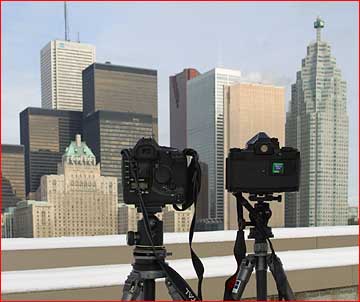
Both cameras were tripod mounted beside each other. The Canon was autofocused on the buildings at infinity and I focused the Pentax manually. Mirror lock-up was used on the Pentax, but not on the Canon. Aperture was set at f/8 on both cameras, close to optimum. Shutter speed was 1/90th sec on the Pentax and 1/250th sec on the Canon (due to ISO 40 with Velvia and ISO 100 with the 1Ds).
As you can see below their coverage matched pretty well, with the 35mm format Canon providing a wider aspect ratio image and therefore showing somewhat more on the horizontal dimension.
The Canon was set to auto color balance and the shot was taken in RAW mode. RAW processing was withCapture Onein 16 bit mode. No USM was applied at this stage. This produced a 63 Megabyte file when loaded into Photoshop. Processing took about 30 seconds.
The Fuji Velvia was processed byBGM, one of Toronto’s leading pro labs, and was subsequently scanned on myImacon Flextight Photoscanner at 3200 PPI in 16 bit mode. No USM was applied at this stage. A 338 Megabyte file was produced when loaded into Photoshop.
In the past when I have done film vs. digital comparisons there is always someone who says, "Ya, the Imacon is a good scanner, but….." Thebutvaries. Sometimes it is that I should have used a higher resolution scanner. Or a 4000 PPI scanner (such as theNikon 8000) orPolaroid 120would have been preferable. Sometimes it’s that only a drum scan can produce a true comparison.
Here’s the deal. I spent $10,000 a few years ago on theImaconbecause I wanted to have the ultimate scanner for my needs. I tested everything on the market. I compared it to the Nikon and the Polaroid,andthe Minolta. I compared Imacon scans to drum scans that I had made by local pro labs. What I found was that I could make better scans with the Imacon than with any of the other desktop scanners, and that while the drum scans produced bigger files I rarely saw much greater resolution from them. Film itself seemed to be the limiting factor.
Nevertheless I knew when I embarked on this new comparison that if I didn’t have a drum scan done there would be those that would find this to be a flaw in my methodology. So I contacted one of the best drum scanning experts in the U.S.A. and had him produce the highest quality drum scan possible. This one frame scan alone costs $300. Since this comparison is a separate issue from what I and most other photographers would normally do I have prepared a seperate report below on my drum scan evaluation and subsequent comparison. Let’s look at the real real-world results first.
Making Sense of the Results
Doing the test is one thing. Making sense of it is another. Below are full frame reproductions of both frames. I used the bit of white snow on the building at bottom-center to set the White Balance. You’ll note that the colour balance is quite different between the two frames, but I didn’t bother trying to match them. This isn’t what the test is about.
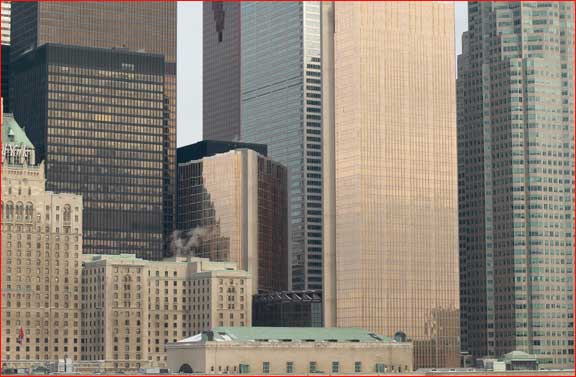
Canon 1Ds
I have also not bothered linking to larger versions of these two frames since there is no visible difference until one gets up toverylarge magnifications. And therein lies the problem. The Pentax 67 film scan is a 158 Megabyte file when reduced to 8 bit mode for printing. The Canon 1Ds file, on the other hand, isonlya 31 Megabyte file. (I never thought I’d see the day when I’d use the word "only" in reference to a 31 MB digital camera file!)
Another way of looking at it is that at a standard printing resolution of 240 ppi the 67 file can produce a 27X36" print, while the 1Ds can only produce an 11X17" print. Quite a difference isn’t it? Should be the end of the story, right?Wrong!
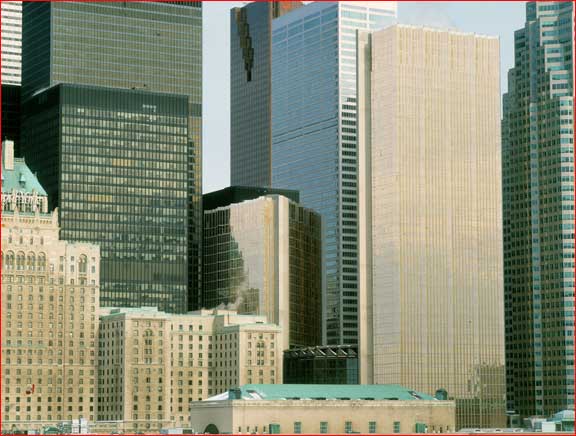
Pentax 67
The Print Evaluation
Now enters the question ofSharpening. There are those that say that evaluations should be done on images that have had no USM applied. To this I say — nonsense! Without USM there is no way to judge what the image really looks like. Accutance needs to be retained during digital imaging processing and that’s what USM is about — accutance. It’s called "sharpening" but it has nothing to do with sharpness (resolution), as some people persist on assuming.
So, what I did was to apply what I considered to be the most appropriate amount of USM to both files. As it turned out I had to apply about 1/3rd more USM to the 6X7 scan than to the 1Ds’ RAW file. This is consistent with my previous experience with both formats.
The next thing that I did was to make a couple of 13 " X 19" prints on anEpson 2200printer at 2800 ppi printer resolution. The 16" wide prints were at 535 ppi for the 6X7 image and the 1Ds file was also 16" wide, but at 255 ppi. No ressing up or down was done.
My evaluation as well as those of several professional photographers who helped me analyze the prints is as follows. Both prints looked very good indeed. But the 1Ds print was sharper. Yes. It really was. Considerably sharper, and every observer could see the difference clearly.
Here is what a close visual examination showed…
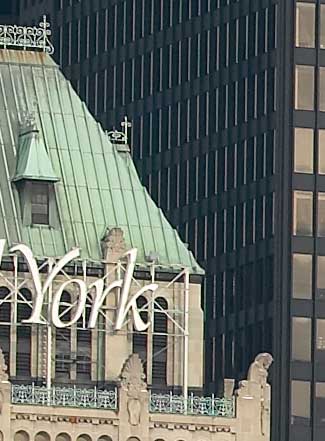
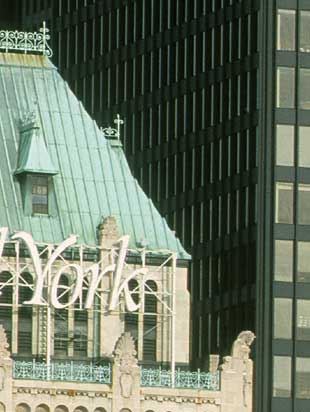
The most obvious difference (other than the overall colour balance — which we ignored), is that the 1Ds print shows more detail. In other words it has higher resolution. Note that the Pentax 67 file was printed at 535 ppi and the Canon 1Ds file was printed at only 255 ppi. Just in case feeding such a large file to the Epson’s printer driver was causing a problem I tried ressing the file down to 300 and then as well to 255 ppi. Same results.
This is astonishing. I therefore made similar comparisons using another set of lenses (the Pentax 300mm f/4 ED/IF and the Canon 70-200mm f/2.8L IS at 150mm). Similar results. Of course the scans were redone just to be sure that this wasn’t the cause. Same results.
The second thing noticed is that the 1Ds file has greater shadow detail. The shadow detail difference can clearly be seen in the example above.
Grain of course is the next important factor, though the result were as expected. Though Velvia is not as fine grained as Provia 100F it still is one of the finest grained colour films around. As you can see, at 100% resolution there is simply no contest. The 1Ds doesn’t start to look this noisy until about ISO 800.
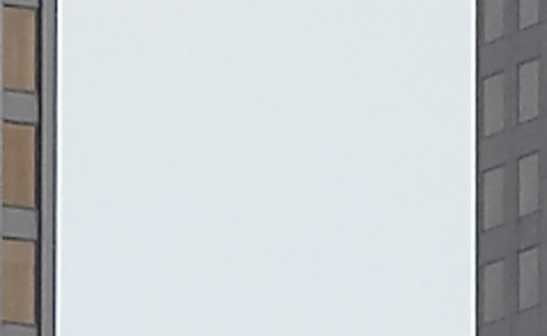
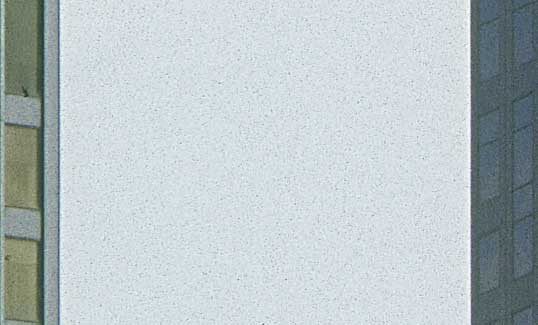
The 1Ds frame above appears to have lower resolution because it is a
MUCH bigger enlargement for this particular comparison than the film scan .
Dust. Remember dust? Not the little out of focus blobs we sometimes get on digital sensors, but the kind of crud you see below. This piece of film was processed by a pro lab and placed immediately from its plastic sleeve to the Imacon’s film holder. Dust. Arghhh.
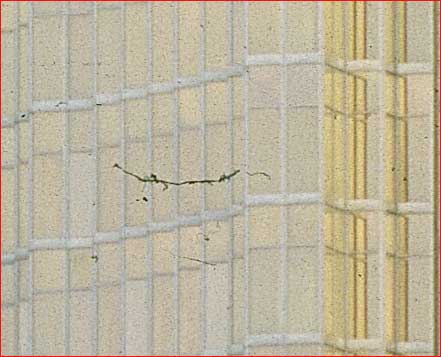
A Question of Size
As mentioned at the start of this article, at a standard printing resolution of 240 ppi the 67 file can produce a 27X36" print, while the 1Ds can only produce an 11X17" print. Yet, as we’ve seen above the smaller file displays higher resolution. This is confusing to some, but size and resolution are separate issues. Bigger is not always better, and in this casedefinitelyis not. But of course the ability of a 6X7 scan at 3200 PPI to make a print almost two and half feet wide is not to be underestimated. An 8000 ppi drum scan can produce a billboard. If you regularly make really huge prints then this is worth considering.
This is an indisputable advantage of working with a larger file. But no amount of ressing up, usingGenuine Fractalsor any other form of digital legerdemain is going to create new bits that aren’t there in the first place, whether from scanned film or a digital camera file. Just consider whether or not those bits contain real information.
My experience is that 1Ds files produce excellent Super B prints (13"X19") with no ressing up, and with just a slight bit of interpolation can make very good 20X24" prints. The 6X7 files on the other hand can easily make 30 X 40" prints. How important this is for you will help determineyourdecision. Since my sale and exhibition prints are never larger than 20X24" I find the 32 MB files produced by the 1Ds more than adequate.
Preliminary Conclusion
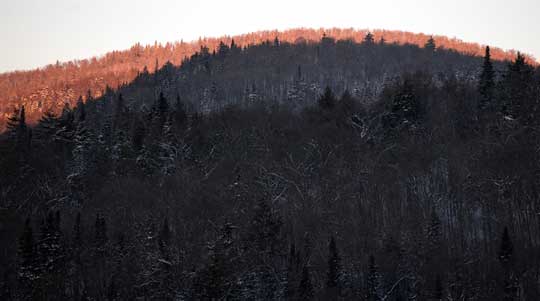
Ridges — Québec. January, 2003
Canon EOS 1Ds with 70-200mm f/2.8L @ 200mm. ISO 100
So, let’s look at the evidence. The pros and cons. The 1Ds produces files that have higher resolution and much finer grain than those from the Pentax 67, and by extension all other medium format cameras. (I shot from 1970-1985 with a Hasselblad 6X6 and Zeiss lenses, and from 1994-2001 with a Rollei 6008 and Schneider lenses. I also have been using a Hasselblad Arcbody with Rodenstock lenses for the past 4 years. The Pentax’s lenses are every bit as good as those others, so don’t imagine that Zeiss or someone elses lenses are going to make any real difference when it comes to resolution compared to the Pentax lenses).
The 1Ds also shows greater shadow detail, and on a personal level I find working with digital files much more efficient and pleasurable than scanning film, and certainly preferable to working in the darkroom. So what advantages does 6X7 film have? Really only absolute image size, and for me at least this isn’t a compelling reason.
Ignoring the possibility of superior performance from medium format film by having drum scans made (which I don’t normally do — not at $100 – $300 per scan) I am only left with the conclusion that I no longer retain any advantage in shooting medium format film. It’s more expensive, less convenient and produces lower quality images. The range of lenses available to me is much greater with 35mm digital, including the availability of longer lenses, wider lenses, more zooms, Image Stabilization, wider aperture primes, and tilt / shift lenses. You can see where I’m going, can’t you?
At least this is the case using the tools and techniques that I have learned over the past 7 years of working digitally and the past 35 years of traditional darkroom work. Would this conclusion be any different if I used a different scanner, different film, and different medium format set-up? I can’t say for sure. I don’t think so though. Do you believe otherwise? Then please go out and do a similar test for yourself. If you get different results please publish them. If you like, and you do a credible job, I’ll publish them here. But don’t base your conclusion on anything other than empirical evidence. Don’t trust what I say, or what others may write. Trust your own eyes. Math and speculation alone will tell you nothing. Do the tests yourself.
I’m surprised with the final outcome. Truly I am. I have had a considerable investment in medium format equipment over the years, but that’s not sufficient reason to keep it. Not if it isn’t going to be used. Better to get the best return from selling them off now rather than in a few years when who knows what the resale value will be?
One more thought. I have done this comparison of high-end digital vs. medium format film using the Canon 1Ds. The reason is simple. That’s what I own and use. Also, as this is written in late January 2003 there is no other 35mm format digital SLR that offers similar performance. TheKodak DCS pro 14nis late to market, and though I’ve been promised one for testing by Kodak for a couple of months, there still isn’t one in sight. I have little doubt that it will perform admirably when it finally ships, but we’ll have to wait and see.
Nikon will undoubtedly drop the other shoe soon — likely at the PMA show in March, 2003. Pentax has a high resolution DSLR coming, as do others. Also, prices will inevitably drop. Right now the 1Ds is only within the financial reach of professional photographers and affluent amateurs. But it’s capabilities will filter down to consumer-grade equipment over the next couple of years and then the revolution will have truly been joined.
Another Opinion
The transition from medium format film to high-end digital is very new, but it is happening very quickly. During the past few months I have personally spoken and had correspondence with a number of leading professional photographers on this topic. Universally their comments echo those ofMelvin Sokolsky, one of America’s top photographers, as reproduced here from a recent commentary made on this site’sDiscussion Forum.
For the past year I have been shooting for various magazines, – Vogue… Harper’s Bazaar…Vibe – with the Canon 1D and recently with the 1Ds. I was told by the math-bound technocrats that I could not print a double page spread with the 1D. – a Vogue spread is 11×17 – only to prove them wrong by printing a Kodak Approval print for the 1D file against the 6×7 film 200mg file drum scanned on a Crossfield. When I asked the printer to pick the Kodak Approval he thought was best; he picked the 1D Kodak Approval. No contest!
…. It is my experience that the 1Ds images appear to be almost grainless and sharper than 6×7 film. Compare prints — any size — from each format and the 1Ds print is chosen every time.— Melvin Sokolsky
One More Thing
My decision to move away from medium format film to 35mm digital (using the Canon 1Ds in particular) is motivated in part by the fact that the Pentax 645 and Pentax 67 systems don’t take interchangeable backs. In that respect I was blindsided by the rapid advancements in digital technology. Knowing what I know now I likely wouldn’t have moved to Pentax, and might have chosen another system instead. The reason for this is that I wouldn’t have been in a dead end with regard to digital capability. (There may be a digital insert for the Pentax 645 some time down the road, but nothing but rumours have been seen yet).
Owners of Hasselblads, Mamiya 645 and Contax 645 have ready access to numerous digital backs, including the self-containedKodak DCS Pro Backwith its 16MP sensor. Owners of these cameras have a migration path into the high-end digital world that I didn’t. While such backs are even more expensive than the already expensive Canon 1Ds, it is an option. Something to ponder.
Enter The Drum Scan
In any film vs. digital comparison there’s always someone that says, "Ya, but what about a drum scan?! No way can a digital camera file equal a drum scan." Right? Well, maybe not.
I rarely do drum scans, mainly because of the cost. A good one can cost between $100 and $300 for a single medium format scan. That’s why I bought theImacon Photoscanner several years ago. It’s only 3200 PPI, but if I’d needed really big scans, to be able to make really big prints, I would have bought a larger model. There are nowImacondesktop scanners that produce up to 8000 PPI scans.
Nevertheless I knew that it would always remain an open question, and I also wouldn’t hear the end of it from others if I didn’t have a drum scan made as part of this comparison. The scan was made by a high-end scanning firm at 5334 PPI. The file that they sent me was about 500MB in 8 bit mode. It’s as good a drum scan as I’ve ever seen.
The scan was done byahigh-end scanning lab on anIsomet 405HRat RES 210.

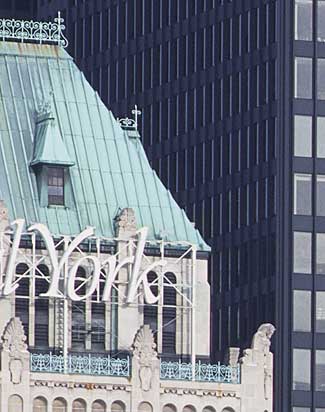

Here’s what I see. On a 13X19" print there’s little to choose between the 1Ds print and the drum scan. I sometimes think that one is sharper or displays higher resolution than the other, and then I look at a different part of the print and think the opposite. Both are clearly higher res than the Imacon scan. As for shadow detail, the drum scan is very similar to the 1Ds, and again both are better than the Imacon scan in this regard.
What else is there to say? Someone will inevitably ask —why didn’t you do a comparison with a traditional wet darkroom print? The answer is because I no longer do them, and the reason is because current inkjet prints surpass chemical prints in every respect. No contest.
Finally, one can argue that the drum scan can produce bigger prints. Yup, they can. But since there clearly isn’t really any significant amount of additionalrealinformation in the drum scan, ressing up the digital file will essentially accomplish the same thing. And, when you figure that the digital file is virtually noise free while the drum scanned film image will display grain in a large print, the choice is clear — at least for me.
Goodbye film. Goodbye medium format.
Ps: If you’d like to write to me about this test and my conclusions, that’s fine. But please don’t write and simply say that you don’t agree. Your opinion carries no weight unless you do a similar side-by-side comparison with the equipment of your choice and make a real-world determination yourself. Don’t spout numbers and formula. Theory alone doesn’t tell you what’s going on. What actually happens in the real world is what photographers need to know.
Michael
Update: February, 2003
In the above artcile I make the claim that the1Dsproduces images superior to medium format drum scans. I took a lot of flack for this when the piece first appeared, even though many pros who I have spoken with and who have started working with the camera are also coming to the same conclusion. It therefore gives me a chuckle (and no small satisfaction) to report that the review of the 1Ds in this month’sShutterbugmagazine byJay Abendcomes to the same conclusion as I did.
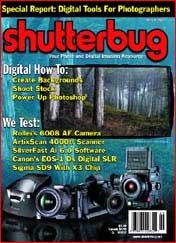
Jay is a well regarded commercial photographer with extensive film and digital experience. He owns and operates his own drum scanner. Here are a couple of brief quotes from his review. "The files look like really good, really clean, really sharp medium format drum scans." and, "It brings medium format image quality to a digital SLR…" Read the review for yourself. Many magazines this month have 1Ds reviews, but most are PR fluff. Jay’s is well written and done from the perspective of a working pro.
You May Also Enjoy...
Midnight Church Iceland
Please use your browser'sBACKbutton to return to the page that brought you here.
